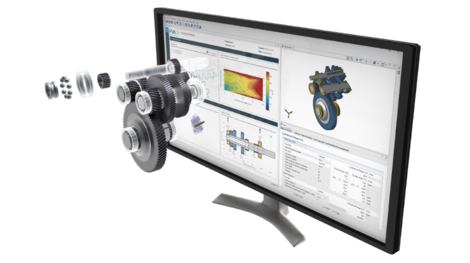System Calculations | Powerful & Stable
Our development team has completely revised system calculations in version 5.0, resulting in performance and stability improvements. A non-linear mechanical model of the full gearbox is created and iteratively solved. In addition to deformations of the shaft-bearing system, the calculations include load distribution of cylindrical gear stages based on analytical models. The influence of the casing and planet carrier stiffness can also be considered.
Reporting | Analysis of Results Has Never Been Easier
With FVA-Workbench 5.0, the classic ASCII and LRZ formats have been replaced with a powerful system for displaying results data and interactive graphics. Documentation of calculation results has been greatly simplified. Customized, attractive, and interactive reports can easily be created using drag & drop. Once they have been created, templates can be used on a wide variety of gearbox models to simplify communication of results with customers and colleagues.
Sample report
Plain Bearing Calculations | State-of-the-Art
As of version 5.0, the new COMBROS kernel can be used to simulate journal as well as thrust bearings according to the current state of research. With this new feature, engineers benefit from high-quality calculation of fixed and titling segments with consideration of pressure, temperature and turbulence effects, even at the highest speeds. The kernel was developed at the TU Clausthal Institute of Tribology and Energy Conversion Machinery and validated on FVA's and FVV's high-performance test stations.
FEM | Coupling of FE and Analytical Models
FVA-Workbench 5.0 supports engineers with fast, user-friendly modeling for analysis of complex gearbox systems. In the calculation, analytical models of machine elements can be coupled with FEM structures. The expanded Z88 interface can now be used to import planet carriers as well as gearbox casings to be integrated and positioned within the gearbox model. To create an efficient workflow, CAD models can now also be directly imported in various native formats in addition to FEM meshes. FEM meshing of the CAD components is then performed internally. A user-friendly meshing assistant is available to provide assistance with automation, simple operation, and interactive guidance. A slider simplifies component defeaturing, making it easy to remove unneeded details from the CAD model. An option for internal generation and parameterization of planet gear geometry has also been provided. This geometry can then be integrated into the FEM mesh, without the need for external planet carrier geometry. This enables quick variation of geometry parameters with direct feedback on the calculation results.
REXS | Exchange of Gearbox Data
The standardized REXS (Reusable Engineering EXchange Standard) interface has been developed in cooperation with research and industry. It can be used for the simple exchange of gearbox data between various programs. REXS (www.rexs.info) import and export functionality is included in FVA-Workbench 5.0 as a new feature.

